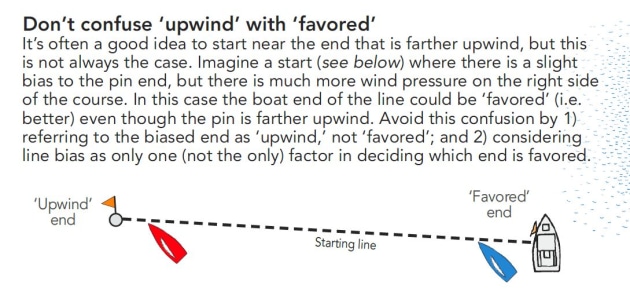David Dellenbaugh, America's Cup winning tactician and world champion strategist and helmsman, publishes a regular bulletin that gives excellent advice on every aspect of yacht racing. His latest 15 page bulletin covers the subject of a startline plan. Here is an extract:
Make a starting plan
The start of any race is a critical moment that can have a big effect on your potential success in that event. If you get off the line cleanly with clear air and good speed, heading to the favored side, you’ve made a great first step. But if you end up going the wrong way, or in the second row with the oxygen masks deployed, you’re in for a long game of catch-up. That’s why you need a good strategy for starting.
Pick a starting spot based on 3 factors
When you set out to develop a starting strategy before each race, the most important thing you need to figure out is where along the line you are going to start. Will you be right at the pin end, a quarter of the way up the line from the pin, a third of the way down from the boat end, or nailing the committee boat? The answer to this question is based on three primary ingredients:
1. Your first-leg strategy
Do you like the left or right side of the first beat? Or the middle? How strong is your preference?
As a rule of thumb you should start on the part of the line that corresponds to your preferred side of the first beat. When you’re not sure, start near the middle and be patient.


2. The starting line ‘bias’
Is the starting line square to the wind or is one end farther upwind? If the end that is upwind matches the side of the course you prefer, your choice of where to start is easy. But if the favored side of the course is opposite to the upwind end of the starting line, you have to decide which one is your priority.

3. Presence of other boats
If there were no other boats on the starting line, you’d probably start close to an end most of the time. In reality, however, there is likely to be a crowd of boats at the end you pick. Do you still want to start there, or is it worth moving away from that end to increase your odds of getting a start with clear air and good speed? This is the third consideration when you’re picking a place to start. Most of the time you should develop a starting strategy before the warning signal so you’re ready to go. But don’t blindly follow that plan. A lot can happen with other boats and the wind during the final few minutes, and this could easily affect your original choice of where to start on the line. So keep your eyes open and remain flexible.

David's bulletin expands on these points and shows how to build a plan that will get you to the top mark in good shape.
To order a copy and to see more of David's work, go to SpeedandSmarts.com, where you can also “test your smarts” in one of David's clever quizes on sailing strategy, tactics and knowledge of the rules.























